Solving First-Order Differential Equations of Z-Numbers’ Initial Value Using Radial Basic Function
Abstract
In this paper, a method was proposed based on RBF for numerical solution of first-order differential equations with initial values that are valued by Z-numbers. The proposed method consists of two parts. The first part has stated the amount of limitation of the fragmentation solution, while the second part has described the assurance of the first part. The limitation section also has two parts. The first part has included the initial condition of the problem, while the second part has included the RBF network. The confidence interval was also considered as a function based on the probability function, which has calculated the confidence level of the first part (limitation). The RBF network or the radial-base grid network has three distinct layers: the input layer that is the set of elementary nodes (sensory units); the second layer is the hidden layers with high dimensions, in which the output layer that has responded to the network response and the activation patterns used in the input layer. The advantage of using RBF is that the use of this technique does not require sufficient information. It only relies on the domain and the boundary. In an example, we have showed that our proposed approach could approximate the problem with acceptable confidence.
1. Introduction
The emergence of a new concept of mathematics called fuzzy sets, the study of fuzzy differential equations, provides a suitable basis for mathematical modeling of real-world issues in which there is ambiguity or some uncertainty. For example, in Science and Engineering, many problems are limited to a set of fuzzy differential equations (FDE) through the process of mathematical modeling. As it is not simple to achieve an exact solution, numerical methods should be utilized [1–8]. One of these methods is the radial basis function (RBF) method.
Generally, radial basis functions are methods, which are based on the location method for interpolation of discrete data while have a high convergence rate [9]. This method is one of the most widely used methods for approximating the functions in the theory of modern approximation [10].
RBFs are first used by Broomhead and Lowe [11]. Much of its use is in the theory, design, and applications of RBF networks [12, 13]. In this paper [14], the use of regulation theory for this group of neural networks is presented as a way to enhance the generalization of the new data. In RBF methods, data are interpolated by linear combinations of functions of a function. This method has been very much considered due to high precision and flexibility versus problem geometry, dimensional independence, and ease of implementation. Today, RBFs are used in some cases such as estimation, modeling, prediction, and classification in various fields, including geosciences [15–19]. Besides, these methods are utilized to solve the numerical differential equations with partial derivatives [20]. The main advantage of numerical methods that use RBF is their nonnetwork characteristic. In nonnetworked methods, it is not necessary to produce a regular network in the domain of the problem, which, due to the high computational cost of network production, is the main advantage of these methods to finite difference methods and finite elements, and so on. The geometric feature used in the RBF approximation is the distance between points. The distance in each space dimension is easily calculated, resulting in higher dimensioning and does not increase the complexity of RBF methods. As stated above, a grid-independent grid function does not require a grid and in spite of our data connections between points; only spatial points are used. Thus, several studies have been used based on RBF to solve various equations. For instance, in [21], the radial function of RBF along with the time-dimensional discretization by the BKM boundary node method and the AEM analogue equation method to solve the time-dependent hyperbolic equations in [22] of RBF to solve time-dependent elliptic equations in [23] of RBF along with the MOL lines in the time dimension to solve the time-dependent nonlinear equations in [24] of RBF using the Kansa idea based on Hermitian interpolation for Fokker–Planck equation. In [25], RBF and quasi-spatial methods to solve the sin-Gordon equation are also used in [26] to use the RBF time-independent functions.
As mentioned, the theory of fuzzy sets is a powerful method to model the uncertainties and processing ambiguity and information dependent on mathematical models. But, they need to be trusted to make this information useful. Human beings have a clear capacity to make rational decisions based on obscure, inaccurate, or incomplete information. Formalization of this capacity is at least somewhat difficult to predict. The author proposed a theorem, called a Z-number, which is a regular pair of fuzzy numbers (A, B) [27]. The first component, A is a limitation for values that have an uncertain variable X that has a value or a real value.The second component, B is a measure of reliability for the first component. Typically, A and B are described with natural disadvantages. For example, about 45 minutes, very sure. Yager used Z-number to calculate the waiting time for a bus [28]. Kang Wang used Z-number to make decisions in an ambiguous environment in 2012 [29]. Ezadi and Allahviranloo initially introduced the Z-based generalized neural network and then estimated the Z-based regression [30]. They also presented methods to rank the Z-numbers in 2017 and 2018 [31, 32]. Also, they, in 2019, introduced the Z-Advanced number process [1]. Further investigations have been carried out on Z-numbers by researchers [33–36]. However, a few studies have been conducted in the field of Z-differential equations [37].
In this paper, we try to provide a numerical method to solve the differential equations with an initial value based on Z-numbers. In Section 2, basic concepts and theorems are presented as well. In Section 3, the network of generalized RBF, radial base functions, is introduced. In Section 4, a method for approximating first-order differential equations with a Z value based on the generalized RBF network is presented. In Section 5, numerical examples are presented and ultimately referenced.
2. Preliminaries
This section provides the necessary definitions and required theorems, which are used to propose the model.
Definition 1. (definition of Z-number).
This valuation for Z according to proposal of Zadeh is observed as a restriction in x and is interpreted as follows [27]:
Indeed, it means that R(y) : y isA⟶Poss(y = u) = μA(u).
Definition 2. (parametric form of Z-numbers).
Assuming that Z∗ is set of Z − numbers, an arbitrary Z-number, Z = (A, B) ∈ Z∗, in the parametric form is represented by an ordered pair of functions:
Definition 3. (normal Z − numbers).
Let us consider Z to be a Z − numbers, where Z = (A, B). We say that Z is a normal Z-number if h(B) = 1, where h(B) is the height of B [37].
Definition 4. (Z-number initial value problem (ZIVP)).
In real world, most of the phenomena are based on doubt and the information, which we have from various subjects such as economic, political, and physics , which have been evaluated according to verbal valuables. Here, we try to formulate and investigate the mentioned information to the initial value problem, while our initial data are Z-numbers. For instance, evaluate the population growth issue with the Z-number data (population growth, very high, usually) in the starting moment t0 and consider how is the information in the next time like in t1. For this purpose, first, we consider a ZIVP as (5), and then we study the existence and uniqueness condition of solution of this problem [37]. Assuming that Z∗ is set of Z-numbers, so, the general form of differential equation initial value based on Z − numbers is defined as follows:
Suppose x′ is a Z-valuation; then, according to [28],
2.1. Gaussian Function Definition
3. RBF Networks
In this regard, wjk is the weight coefficient between j middle neurons and the k neuron of the output layer and ϕj, the output of j is the middle layer neuron. The results of the outcomes were evaluated using root mean square error statistics, RMSE, and determination coefficient R2. One of the important points in the RBF network is the choice of the type of transfer function, which is the responsibility of the modeling person. One of the important issues is the attention to the characteristics and statistical variables of the data. For example, if the RBF type is Gaussian, the width of the function is important, which should be chosen so that the distance between the data points is larger, and the dimension of the data is smaller. One of the other issues in designing RBF networks is the number of centers used in the middle layer. As the selection of these centers is directly related to the accuracy and complexity of the network, these centers should be chosen to balance the desired accuracy and complexity.
4. Solving First-Order Differential Equations of Z-Numbers’ Initial Value Using Radial Basic Function (RBF)
Theorem 1. ZIVP (12) has a unique Z-process solution.
Proof. Based on [27], relation (12) and relation (13) are equivalent. In (13), is a fuzzy function, and it is introduced on relation (14). For each α-cut, relation (14) and relation (15) are equivalent. On the other hand, the fuzzy initial value problem in (15) has a unique solution (based on Theorem (3.2) in [40]). Similarly . Therefore, it is obvious that ZIVP (12) has a unique solution.
In the general process for obtaining the solution of equation (12) with nonnetworked physical domain methods, we present the problem as a set of scattered points in the domain. These points can be regular or irregular, but they must cover the entire domain in any case. We then approximate the unknown function at any point in the domain. In this way, we consider a base for the solution space and a solution as a linear combination of the base members. In this process, this solution is expanded in terms of base functions. Therefore, the coefficients of the basic sentences are unknown to us. These coefficients must hold in the equations. In the cases where basic radial functions for inwardness are used, the number of centers with the dimension of input data is considered equal in order to achieve high precision. In this paper, we propose a method using the RBF of the generalized RBF-based Z-based numbers in such a way that the initial condition of the main problem is to be established as follows:
If xT is , then possibility (xT is ) is .
Here, we define as follows ( is a derivative function):
| Function name | Mathematical relation |
|---|---|
| Linear | ϕ(r) = r |
| Cubic | ϕ(r) = |r|3 |
| Narrow page | ϕ(r) = r2ln|r| |
| Making | ϕ(r, ε) = (1/1 + εr) |
| Robey inversion | ϕ(r, ε) = (1/1 + (εr)2) |
| A few rebates | |
| Multiple reverses |
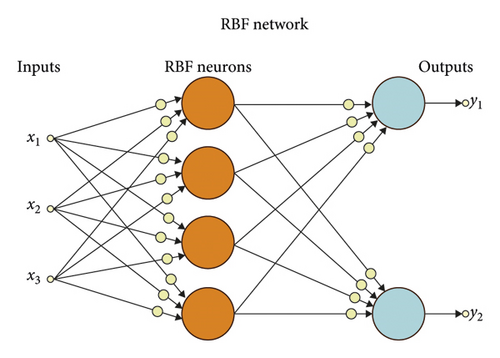
The value of is also a fuzzy number, which must be computed.
4.1. The Numerical Modeling of the Grid Radial Base Function
5. Numerical Examples
In this section, to show the behavior and properties of this new method, we discuss the simulation results of one example. The simulation is conducted on Matlab12, and the objective function in (12) minimizer engaged is fminunc. The initial weights were randomly selected.
Example 1. Consider the following first-order FDE:
The exact solution of the FDE is
Assume that the initial value based on Z-numbers is as follows:
In this case, differential equation (34) can be rewritten as follows:
And assume that the exact solution of the ZDE is
Our proposed method is as follows:
Comparison of the approximate solution with the RBF network training for 50 points and with a choice of λ = 1 is shown in Table 2. The convergence of the neural network weights for each r-cut is shown in Figure 2. Comparison of the approximate method with the exact method is shown in Figure 3. The comparison of the confidence level of the actual answer and the approximate solution is shown in Figure 4.
| r | BT(t) | B (t) | ||||
|---|---|---|---|---|---|---|
| 0 | 2.00 | 2.03 | 3.04 | 3.05 | 0.874 | 0.872 |
| 0.1 | 2.07 | 2.10 | 3.02 | 3.02 | 0.885 | 0.885 |
| 0.2 | 2.14 | 2.17 | 2.99 | 2.99 | 0.899 | 0.898 |
| 0.3 | 2.21 | 2.24 | 2.95 | 2.95 | 0.911 | 0.912 |
| 0.4 | 2.28 | 2.31 | 2.92 | 2.92 | 0.925 | 0.925 |
| 0.5 | 2.35 | 2.37 | 2.88 | 2.88 | 0.937 | 0.937 |
| 0.6 | 2.42 | 2.44 | 2.84 | 2.85 | 0.950 | 0.949 |
| 0.7 | 2.50 | 2.51 | 2.81 | 2.82 | 0.962 | 0.962 |
| 0.8 | 2.57 | 2.58 | 2.78 | 2.78 | 0.975 | 0.975 |
| 0.9 | 2.64 | 2.65 | 2.75 | 2.75 | 0.987 | 0.987 |
| 1 | 2.71 | 2.71 | 2.71 | 2.71 | 1 | 1 |
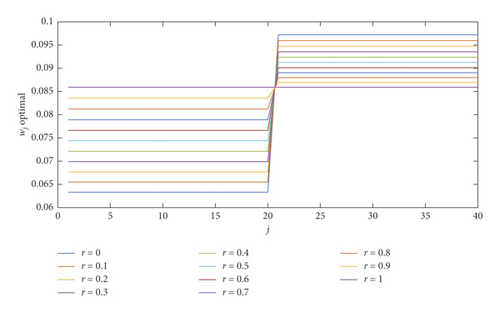

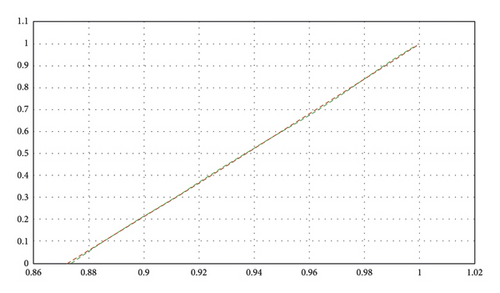
Example 2. Consider the following first-order ZDE:
The exact solution of the FDE is
Assume that the initial value based on Z-numbers is as follows:
In this case, differential equation (34) can be rewritten as follows:
And assume that the exact solution of the ZDE is
Our proposed method is as follows:
Comparison of the approximate solution with the RBF network training for 50 points and with a choice of λ = 1 is shown in Table 3. The convergence of the neural network weights for each r-cut is shown in Figure 5. The comparison of the approximate method with the exact method is shown in Figure 6. The comparison of the confidence level of the actual answer and the approximate solution is shown in Figure 7.
| r | BT(t) | B (t) | ||||
|---|---|---|---|---|---|---|
| 0 | −0.000000002 | 0 | 1.87 | 1.90 | 0.687 | 0.663 |
| 0.1 | 0.41 | 0.42 | 1.85 | 1.87 | 0.769 | 0.754 |
| 0.2 | 0.58 | 0.60 | 1.82 | 1.84 | 0.804 | 0.793 |
| 0.3 | 0.72 | 074 | 1.79 | 1.81 | 0.833 | 0.824 |
| 0.4 | 0.83 | 0.85 | 1.76 | 1.78 | 0.856 | 0.848 |
| 0.5 | 0.93 | 0.96 | 1.72 | 1.74 | 0.878 | 0.873 |
| 0.6 | 1.02 | 1.05 | 1.68 | 1.90 | 0.899 | 0.866 |
| 0.7 | 1.11 | 1.13 | 1.64 | 1.65 | 0.919 | 0.916 |
| 0.8 | 1.19 | 1.21 | 1.58 | 1.60 | 0.940 | 0.937 |
| 0.9 | 1.27 | 1.28 | 1.51 | 1.53 | 0.963 | 0.960 |
| 1 | 1.34 | 1.35 | 1.34 | 1.35 | 1 | 1 |
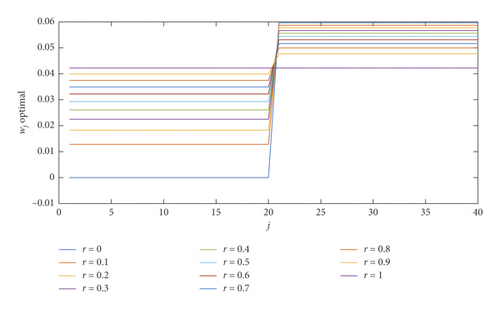
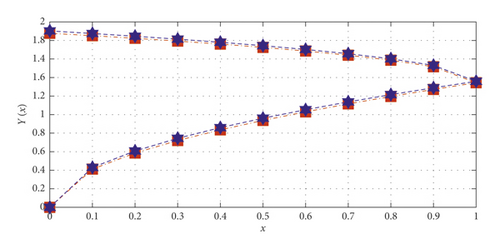

6. Concluding Remarks
In this paper, we proposed a new approach for solving first-order differential equations of Z-numbers’ initial value under uncertainty using radial basic function under generalized H-differentiability. At first, the problem was divided into two parts: the first part of the limitation and the second part of the reliability of the first part. We employed the RBF method for finding upper and lower solutions of the equation of the problem limitation section. The main advantage of this approach is that the fuzzy equation was reduced to the problem of solving two systems of linear equations. Then, we use the information obtained of the proposed method of the first part to calculate the confidence level, and an exponential function was proposed to calculate the reliability of a function. The numerical investigation presented in this paper shows that excellent accuracy can be obtained even when few nodes are used in analysis. In contrast, many more nodes are needed to achieve relatively good accuracy in other methods. Numerical example is included to demonstrate the validity and applicability of the technique and is performed on a computer using a code written in Matlab. The method can be implemented for solving linear and nonlinear equations in higher dimensions.
Conflicts of Interest
The authors declare that they have no conflicts of interest.
Open Research
Data Availability
No data were used to support this study.




